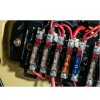First off, Hello.
My name is Frank and I'm from Victoria down here in Australia. I'm into cars hence the reason for joining this forum. I do a fair bit of camping so enjoy setting up the LandRover for that purpose. However I'm working on a different project now and need some expert advice on a few thing from fuses to controllers to raise and lower a spoiler at preset speeds.
The first ling I'd like help to address is the changing of a fuse panel. Currently it uses the old ceramic fuses and the crimped end wires are held on each side by a screw block.
I'd like to change this to something that takes common blade type fuses.
After I take some pics I'll post them here.
TIA
Frank
My name is Frank and I'm from Victoria down here in Australia. I'm into cars hence the reason for joining this forum. I do a fair bit of camping so enjoy setting up the LandRover for that purpose. However I'm working on a different project now and need some expert advice on a few thing from fuses to controllers to raise and lower a spoiler at preset speeds.
The first ling I'd like help to address is the changing of a fuse panel. Currently it uses the old ceramic fuses and the crimped end wires are held on each side by a screw block.
I'd like to change this to something that takes common blade type fuses.
After I take some pics I'll post them here.
TIA
Frank
Last edited:


